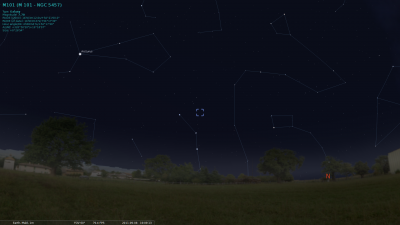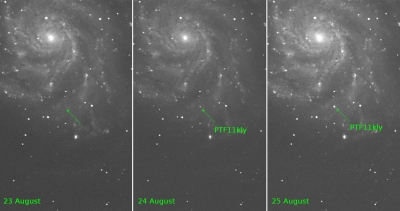Wednesday, September 7. 2011
Rare chance to witness a Supernova, right now!
The astronomy community has been abuzz lately with the discovery of a supernova, dubbed SN2011fe, in the Pinwheel spiral galaxy. This is the 136th supernova discovered this year but what makes this particular supernova special is that this one is the closest of its kind discovered since 1986 and astronomers believe it was discovered just hours after it went supernova. It also presents an exciting opportunity for the public as it is visible with the aid of binoculars or a small telescope!
The supernova was discovered by the Palomar Transient Factory survey for supernovas on 24th August. The supernova was located to the Pinwheel Galaxy (M101) in the easily identifiable constellation Ursa Major (a.k.a. Great Bear), and has been brightening since discovery. It is expected to reach peak brightness on 9th September.
The fact that the supernova was located to the Pinwheel Galaxy which is about 21 million light years away, means that this event actually took place 21 million years ago! It is only now that light from the event has completed its long journey and is reaching us here on Earth.
If you have a good set of binoculars or a telescope, you can attempt to view the supernova yourself. For Maldives, the Pinwheel Galaxy is currently located very low on the horizon at sunset and sinks below the horizon around 9pm.
If you have a computerised telescope, get it to locate the Messier object M101 for you. Or you can use your choice of stargazing application on a smartphone or tablet device to locate the Pinwheel galaxy.
If you don't have either of those, locate the "handle" of the Big Dipper asterism in Ursa Major and extend an imaginary line from the last two stars to form an equilateral triangle - you should find yourself looking at the Pinwheel Galaxy and the supernova SN2011fe as a bright point.
A supernova is the violent explosion of star, which results in a burst of radiation that could outshine the star's host galaxy and could radiate as much energy as our Sun emits in its entire lifespan. The SN2011fe supernova is classed as a Type 1a supernova, which is thought to occur when a white dwarf star starts to siphon off material from a nearby star and accretes enough material, increasing temperature and density, that nuclear fusion is triggered. Supernovae happen all the time and astronomers have observed many a supernovae over the years but there is still much to be understood about them.
The supernova was discovered by the Palomar Transient Factory survey for supernovas on 24th August. The supernova was located to the Pinwheel Galaxy (M101) in the easily identifiable constellation Ursa Major (a.k.a. Great Bear), and has been brightening since discovery. It is expected to reach peak brightness on 9th September.
The fact that the supernova was located to the Pinwheel Galaxy which is about 21 million light years away, means that this event actually took place 21 million years ago! It is only now that light from the event has completed its long journey and is reaching us here on Earth.
Observing
If you have a good set of binoculars or a telescope, you can attempt to view the supernova yourself. For Maldives, the Pinwheel Galaxy is currently located very low on the horizon at sunset and sinks below the horizon around 9pm.
If you have a computerised telescope, get it to locate the Messier object M101 for you. Or you can use your choice of stargazing application on a smartphone or tablet device to locate the Pinwheel galaxy.
If you don't have either of those, locate the "handle" of the Big Dipper asterism in Ursa Major and extend an imaginary line from the last two stars to form an equilateral triangle - you should find yourself looking at the Pinwheel Galaxy and the supernova SN2011fe as a bright point.
What is a Supernova?
A supernova is the violent explosion of star, which results in a burst of radiation that could outshine the star's host galaxy and could radiate as much energy as our Sun emits in its entire lifespan. The SN2011fe supernova is classed as a Type 1a supernova, which is thought to occur when a white dwarf star starts to siphon off material from a nearby star and accretes enough material, increasing temperature and density, that nuclear fusion is triggered. Supernovae happen all the time and astronomers have observed many a supernovae over the years but there is still much to be understood about them.





